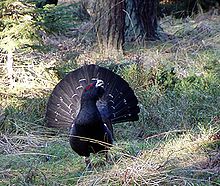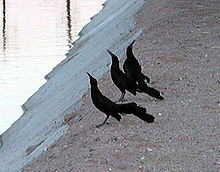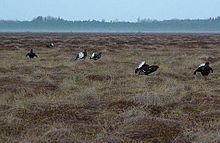Lek mating

A lek is an aggregation of male
A classical lek consists of male territories in visual and auditory range of each other. An exploded lek, as seen in the kākāpō (the owl parrot), has more widely separated territories, but still in auditory range. Lekking is associated with an apparent paradox: strong sexual selection by females for specific male traits ought to erode genetic diversity by Fisherian runaway, but diversity is maintained and runaway does not occur. Many attempts have been made to explain it away,[2][3][4][5] but the paradox remains.
Etymology
The term derives from the
Taxonomic range
Lekking was originally described in the
The presence of a group name means that some species in that group lek; groups with no lekking members are not shown.
| Nephrozoa |
| ||||||||||||||||||||||||||||||
Lekking behaviour

Types
There are two types of lekking arrangement: classical and exploded. In the classic lekking system, male territories are in visual and auditory range of their neighbours. In an exploded lek, males are further away from one another than they would be in a classical lek. Males in an exploded lek are outside visual range of one another, but they stay within earshot.[35] Exploded lek territories are much larger than classic systems and more variable in size.[36] A well-known example of exploded leks is the "booming" call of the kākāpō, the males of which position themselves many kilometres apart from one another to signal to potential mates.[37]
Stability
Lek territories of different taxa are stable and do not vary in terms of size and location.[38] Males often return to the same mating sites because of female fidelity.[39] Avian females such as the black grouse and great snipe are faithful to males and not to mating sites.[40] Successful males congregate in the same area as the previous breeding season because it is familiar to them, while females return to reunite with their males. Females do not return to a mating site if their male partner is not present.[40] Another possible explanation for lek stability is from male hierarchies within a lek. In some species of manakin, subordinate betas may inherit an alpha's display site, increasing the chances of female visitation.[40] Rank may also contribute to the stability of lek size, as lower ranking males may congregate to achieve a perceived optimal size to attract females.[41]
Female mating preferences
A meta analysis of 27 species found that qualities such as lekking size, male display rate, and the rate of male aggression exhibit positive correlation with male success rates.[1] A positive correlation was also found between attendance, magnitude of exaggerated traits, age, frequency of fights, and mating success.[1] This female preference leads to mating skew, with some males being more successful at copulating with females. The variation in mating success is quite large in lek mating systems with 70–80% of matings being attributed to only 10–20% of the males present.[42]
Costs and benefits
The main benefit for both sexes is mating success. For males, the costs stem from females' preferences. The traits that are selected for may be energetically costly to maintain and may cause increased predation. For example, increased vocalization rate caused a decrease in the mass of male great snipes.[43] Other costs can derive from male combat. For example, male great snipes regularly fight to display dominance or defend their territory, with females preferring victorious males.[43] Aggressive male black grouse are preferred over non-aggressive males and when the males fight they tear feathers from each other's tails.[44] Lekking is associated with sexual dimorphism across a range of bird taxa.[7]
At first glance, it may seem that females receive no direct benefits from lekking, since the males are only contributing genes to the offspring in the absence of parental care or other benefits.[45] However, lekking reduces the cost of female searching because the congregating of males makes mate selection easier.[46] Females do not have to travel as far, since they are able to evaluate and compare multiple males within the same vicinity. Further, having the males in one place may reduce the amount of time a female is vulnerable to predators. When under predatory pressure, female marbled reed frogs consistently choose leks near their release sites; high male calling rates were observed to reduce female search time.[47]
The lek paradox

Since

Evolution
Several possible mechanisms have been proposed as to why males cluster into leks, including the hotshot, hotspot, black hole, kin selection, and predation protection hypotheses, as described below.
Hotshot hypothesis
The hotshot hypothesis is the only model that attributes males as the driving force behind aggregation. The hotshot model hypothesizes that attractive males, known as hotshots, garner both female and male attention.
Hotspot model

The hotspot model considers the female density to be the catalyst for the clustering of males. This model predicts that leks will form where females tend to reside as a way to increase female interaction.[3] Female manakin traffic has been observed to be concentrated around leks, bathing sites, and fruiting areas, with males aggregated near the most visited fruiting resources.[3] The hotspot model also predicts that lek size is dependent upon the number of females inhabiting a patch of land.[2] To test if the number of females affects lek formation, a group of female little bustard decoys were added to a lek. The presence of these female decoys did not have an effect on lek size, tending to refute the hypothesis.[4]
Blackhole model
The blackhole model proposes that females have a preference for neither size nor type of male, but rather that females tend to be mobile and mate wherever leks may be located.
Kin selection

An alternative hypothesis for lekking is
Predation protection
Another hypothesis is predation protection, or the idea that there is a reduction in individual predation risk in a larger group.[4] This could work both for the males within the group and any female who visits the lek.[62] Protection also explains the presence of mixed leks, when a male of one species joins a lek of another species for protection from a common set of predators. This occurs with manakins,[63] as well as other birds such as grouse species.[64]
References
- ^ .
- ^ S2CID 85295271.
- ^ S2CID 1886240.
- ^ S2CID 2527129.
- ^ S2CID 36424100.
- Frederick Warne & Co. pp. 219ff.. Lloyd also borrows 'Lek-ställe' (Swedish lekställe, "play-place") for "pairing ground".
- ^ S2CID 26713188.
- PMID 24686934.
- ^ Ponomarenko, I. Ja (1965). "Comparative characteristics of some biological indices of the bottom stages of 0-group cod belonging to the 1956, 1958, 1959, 1960 and 1961 year-classes". Spec. Publ. Int. Comm. Northwest Atlantic Fish: 349–354.
- S2CID 85368424.
- S2CID 54249065.
- S2CID 10792384.
- S2CID 25770747.
- PMID 17593966.
- .
- .
- S2CID 54229602.
- S2CID 23311725.
- .
- S2CID 23311725.
- .
- S2CID 25266746.
- PMID 11058729.
- S2CID 53203396.
- S2CID 53201501.
- S2CID 22011338.
- S2CID 53161684.
- S2CID 27843985.
- .
- .
- PMID 28567739.
- ^ Marshall, S. A. (2000). "Agonistic behaviour and generic synonymy in Australian Clusiidae (Diptera)". Studia Dipterologica. 7: 3–9.
- ISBN 978-0-534-16566-6.[page needed]
- ISBN 978-0-385-08476-5.[page needed]
- PMID 28567800.
- S2CID 8785010.
- .
- PMID 19324796.
- ^ JSTOR 24110971.
- ^ S2CID 20512716.
- .
- S2CID 84269919.
- ^ S2CID 24980393.
- S2CID 4303268.
- S2CID 84996792.
- S2CID 25290065.
- S2CID 53206142.
- PMID 17341455.
- ^ PMID 28581098.
- S2CID 4366707.
- ^ PMID 16701278.
- ^ S2CID 85631446.
- PMID 1195756.
- PMID 28563835.
- PMID 7123238.
- S2CID 43984154.
- S2CID 51779413.
- .
- PMID 7973654.
- JSTOR 23736806.
- S2CID 4394886.
- S2CID 10795904.
- PMID 18853359.
- PMID 12573063.
